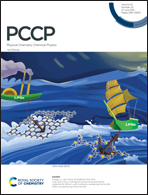Effects of molecular shape on alcohol aggregation and water hydrogen bond network behavior in butanol isomer solutions
Abstract
Despite butanol isomers such as n-butanol, sec-butanol, isobutanol and tert-butanol having the same chemical formula, their liquid–liquid phase diagrams are distinct. That is, tert-butanol is miscible in water at all concentrations, while the other three butanol isomers are partially miscible under ambient conditions. The molecular shape of tert-butanol is close to globular and differs from the other three butanol molecules with a relatively long carbon chain. By performing molecular dynamics simulations and graph theoretical analysis of the four water–butanol isomer mixtures at varying concentrations, we show how distinct butanol aggregates are formed which depend upon the molecular shape and affect the water H-bond network structure and phase diagram in the binary liquid. The three butanol isomers of n-butanol, sec-butanol and isobutanol at concentrated solutions form chain-like alcohol aggregates, but tert-butanol forms small aggregates due to the distinct packing behavior caused by its globular molecular shape. By employing the graph theoretical analysis such as the degree distribution and the eigenvalue spectrum from the adjacency matrix in the graphical representation of the alcohol H-bond network, we show that the tert-butanol aggregates have a different morphological structure from that of the other three butanol isomers in aqueous solution. The graph theoretically distinct butanol aggregates are categorized into two groups, water-compatible and water-incompatible, depending upon the interaction between the alcohol and water molecules. Based upon our observations, we propose that the water-incompatible networks of n-butanol, sec-butanol and isobutanol aggregates do not change the water structure significantly, forming two separate liquid phases that are alcohol-rich and water-rich. However, the water-compatible network of tert-butanol aggregates has a considerable interaction with the water molecules and causes significant disruption of the water H-bond network, forming a homogeneous solution. Understanding the alcohol aggregation behavior and water structure in butanol–water mixtures provides a critical clue in appreciating fundamental issues such as miscibility and phase separation in aqueous solution systems.

- This article is part of the themed collection: 2021 PCCP HOT Articles


 Please wait while we load your content...
Please wait while we load your content...